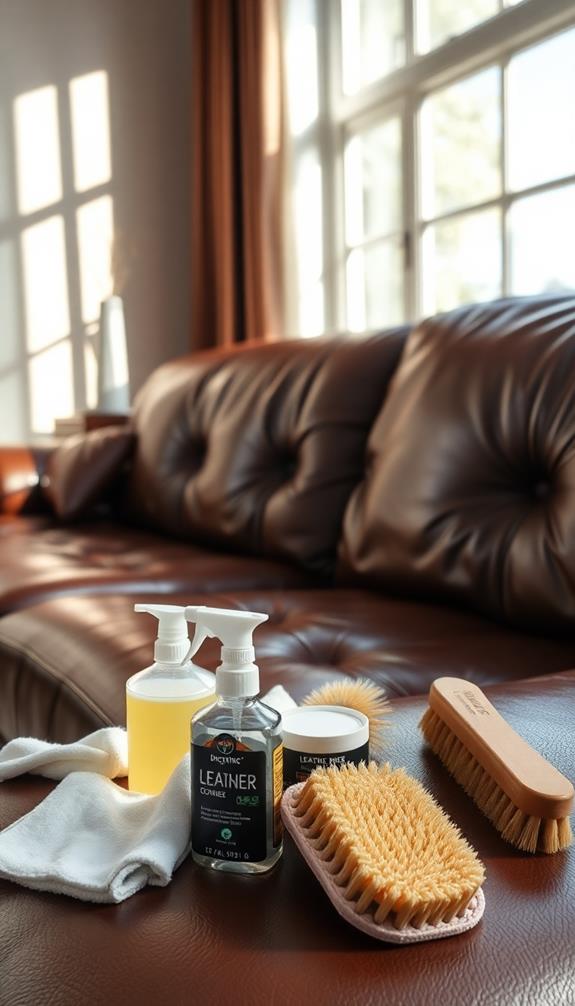To deep clean your couch, start by identifying the fabric's cleaning code. For water-safe fabrics, vacuum thoroughly, then use a mix of dish soap and water to gently blot stains. For microfiber, spray rubbing alcohol on stains and scrub with a sponge. If you have a leather couch, wipe it down with a microfiber cloth and use a specialized cleaner. Don't forget to sprinkle baking soda to combat odors and vacuum it up after 30 minutes. With these tips, your couch will look great. Keep going to discover even more techniques tailored to each fabric type!
Understanding Upholstery Cleaning Codes
Understanding upholstery cleaning codes is fundamental for maintaining your couch without causing damage. Each code offers essential information on how to clean your fabric safely.
The code W means you can use water-based cleaners, which are generally safe for most upholstery. For instance, regular maintenance, including vacuuming and addressing spills promptly, can help keep your furniture looking fresh and clean best practices for upholstery care.
If you see W/S, both water- and solvent-based cleaning products are acceptable, giving you more flexibility in your cleaning methods.
Fabrics marked with an S can only be cleaned with solvent-based products. Using water on these fabrics can lead to damage, so it's important to follow the code.
Cleaning Fabric and Microfiber Couches
Cleaning fabric and microfiber couches requires a careful approach to maintain their look and longevity.
Start the cleaning process by thoroughly vacuuming your upholstered furniture using an upholstery attachment, as this helps remove dust and debris that can accumulate in hard-to-reach areas. Don't forget to get under the cushions to remove dust and debris effectively.
For a more thorough cleaning, consider utilizing a microfiber cloth to pick up any loose dirt, and for those tough food stains, you might want to use enzyme cleaners for tough stains that can effectively break down messes.
Next, consider using a handheld steamer or steam iron to deep clean fabric and eliminate dust mites, ensuring you sanitize all areas of the couch.
For spot cleaning stubborn stains, opt for enzyme cleaners for food or pet-related messes, or use water- or solvent-based cleaners for S-coded fabrics. Always test your cleaning solution in a hidden area first to avoid damage.
After addressing stains, apply a fabric sanitizing spray to eliminate bacteria and odors, enhancing the freshness of your couch.
Deep Cleaning Leather Couches

When it comes to deep cleaning leather couches, having the right tools is essential for effective results.
Regular maintenance, such as using a gentle cleaning solution and soft microfiber cloths, can prevent dirt buildup and keep your leather looking pristine.
You'll want to follow a step-by-step process to guarantee every inch is spotless, and don't forget about consistent cleaning techniques to keep your couch looking great.
Let's break down what you need and how to keep your leather in top shape.
Essential Cleaning Tools Needed
To effectively deep clean your leather couch, you'll need a few essential tools that make the process easier and more efficient.
Start with a high-quality microfiber cloth, which allows you to wipe away dust and dirt without scratching the leather's surface. A vacuum with a crevice tool is vital for getting into seams and buttons, ensuring you remove all debris, including pesky dust mites hiding in those hard-to-reach areas.
Next, invest in a specialized leather cleaner. Apply it using a damp cloth to maintain the leather's integrity while effectively removing stains.
After cleaning, use a soft, dry cloth to rinse off the leather cleaner and buff the surface, restoring its shine and preventing any residue buildup.
Step-by-Step Cleaning Process
Deep cleaning your leather couch can feel like a challenging task, but it's actually quite manageable with the right approach.
Start by using a microfiber cloth to wipe down the leather surface, removing crumbs and dirt. Next, vacuum the crevices and seams with a crevice tool for a thorough clean.
Now, it's time to apply the cleaning product. Use a specialized leather cleaner on a damp cloth, working in small sections to avoid over-saturating the leather. Always test the cleaner on an inconspicuous area first.
If you encounter stains, blot the stain gently to remove stubborn spots without damaging the leather.
After cleaning, rinse the area with a separate damp cloth to eliminate any cleaner residue. Then, buff the surface with a dry cloth for a polished finish.
To maintain the leather's condition, apply a leather protectant after cleaning; this helps in future stain removal and prevents drying or cracking.
Maintenance Tips for Longevity
Maintaining your leather couch is essential for keeping it looking great and extending its lifespan. Start by regularly wiping down the surface with a clean cloth, preferably microfiber, to remove crumbs and dirt. This simple maintenance task helps prevent buildup and keeps your couch in top shape.
Don't forget to vacuum the seams and buttons using a crevice tool; this will effectively remove trapped dust and allergens from hard-to-reach areas.
For deeper cleaning needs, apply a leather cleaner with a damp cloth, working in small sections. Always follow up by rinsing with a clean damp cloth to avoid residue buildup.
Additionally, using a leather conditioner every 6-12 months keeps the leather supple and prevents cracking, contributing to your couch's longevity.
Be mindful to avoid exposing your leather couch to direct sunlight or excessive moisture, as these conditions can lead to fading and damage over time.
Eliminating Odors From Couch Fabric
Eliminating odors from couch fabric can transform your living space into a fresher, more inviting environment. One of the simplest methods is using baking soda, which is a key ingredient in many homemade furniture deodorizers.
Sprinkle it generously over the fabric, allowing it to sit for at least 30 minutes to absorb the odors. Afterward, vacuum it off to reveal a cleaner couch.
For a quick refresh, consider using Febreze FABRIC spray. This product effectively neutralizes odors, but be careful not to oversaturate the fabric. Spray it evenly across the entire surface for the best results.
Regular maintenance is key to keeping odors at bay. After any spills or pet accidents, address the situation immediately to prevent smells from setting in.
Identify common sources of odors, like greasy takeout or wet dog smells, and tackle them promptly.
Both baking soda and Febreze are effective methods for eliminating couch odors. By incorporating these steps into your cleaning routine, you can maintain a fresh-smelling couch and a more pleasant living space overall.
Techniques for Different Couch Fabrics

When it comes to cleaning different couch fabrics, you need to tailor your approach.
For cloth couches, a DIY cleaner with dish soap and vinegar works wonders, while microfiber couches require rubbing alcohol for tough stains.
It's also important to check fabric care labels to guarantee you're using the right cleaning methods for each type.
Knowing these techniques will help keep your furniture looking fresh and inviting.
Cloth Couch Cleaning Tips
Cleaning a cloth couch requires specific techniques tailored to the fabric type. Start by brushing the fabric with a stiff brush to loosen dried debris.
Then, vacuum thoroughly to remove dust and dirt. For tougher stains, create a DIY cleaning solution using dish soap, vinegar, and warm water. Apply this cleaner with a clean cloth, gently blotting and rubbing the area to lift the stains without causing discoloration.
If you notice any lingering odors, sprinkle baking soda on the sofa. Let it sit for at least 30 minutes before vacuuming it off for a fresh scent.
Always test any cleaning solution in an inconspicuous area first to verify it won't damage the fabric.
Regular maintenance is key to keeping your fabric couch looking its best. Make vacuuming and spot cleaning a routine.
This won't only help you tackle water stains or other spills effectively but also extend the lifespan of your couch.
With these tips, you'll maintain a clean and inviting sofa that enhances your living space.
Microfiber Couch Maintenance Techniques
Over time, maintaining a microfiber couch can seem challenging, but with the right techniques, it's manageable.
Start by regularly vacuuming your couch with an upholstery attachment to remove dust and dirt. This routine maintenance helps preserve its appearance and prolongs its lifespan.
If you encounter stains, grab a spray bottle and fill it with rubbing alcohol. Lightly mist the stained area and let it evaporate before gently scrubbing with a light-colored sponge to lift the stain.
Always test this solution on a hidden part of the couch first to verify it doesn't damage the fabric or alter its color.
For water stains, use distilled water for spot cleaning. This prevents minerals from tap water from leaving further marks.
After cleaning, brush the microfiber in circular motions to restore its texture and prevent unsightly patterns.
These simple techniques will help you keep your microfiber couch looking clean and fresh.
Professional Cleaning Services and Resources
Professional cleaning services often provide an efficient solution for deep cleaning your couch, tackling tough stains and allergens that regular cleaning might miss. Companies like Molly Maid utilize specialized equipment and cleaning techniques designed to remove tough stains and pollutants, ensuring your couch looks and feels fresh.
Additionally, many of these services employ eco-friendly cleaning products that are both effective and safe for your home environment.
With over 450 franchises across the U.S., you have convenient access to tailored cleaning services that fit various schedules and household needs. You can easily find local experts by entering your ZIP code or calling Molly Maid at (800) 654-9647 for inquiries. This makes it simple to access professional help when you need it most.
Molly Maid's Neighborly Done Right Promise guarantees customer satisfaction, ensuring their cleaning services meet high standards and exceed your expectations.
In 2022, they completed 1.7 million cleaning services, with 90% of customers returning for additional help, highlighting the effectiveness and reliability of their offerings.
Conclusion
Just like a gardener tends to their plants, nurturing them back to health, you can breathe new life into your couch with a little care and attention. By understanding your upholstery and using the right techniques, you not only refresh your furniture but also create a cozy haven in your home. Remember, every fabric type has its own story, and with your diligent cleaning, you'll guarantee those stories continue to bring comfort and joy for years to come.